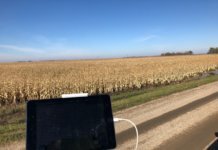 Oregon BEST, a nonprofit cleantech organization, and the Portland Development Commission have awarded $150,000 to HoneyComb Corp., a Wilsonville, Ore.-based start-up that is developing unmanned aerial systems (UAS) for use in precision agriculture and forestry applications.
Oregon BEST, a nonprofit cleantech organization, and the Portland Development Commission have awarded $150,000 to HoneyComb Corp., a Wilsonville, Ore.-based start-up that is developing unmanned aerial systems (UAS) for use in precision agriculture and forestry applications.
The funding, Oregon BEST says, is helping HoneyComb collaborate with Oregon State University (OSU) researchers to verify that data collected by the company's UAS flying over croplands and forests is accurate. Oregon BEST notes that part of the funding supports data collection and analysis known as ‘ground truthing’ – that is, sending technicians into the field to gather data on the ground to compare with remote sensing data collected by aerial photography, infrared images, etc.
According to Oregon BEST, the HoneyComb system measures reflectance in the visible and near-infrared spectrum, which can be used to calculate the normalized difference vegetation index, an indicator of crop stress. In imagery, healthy and vigorous plants are colored green, whereas highly stressed plants are red. This allows growers, farm consultants or service providers to quickly hone in on problem areas, the organization adds.
The funding, Oregon BEST reports, is also enabling HoneyComb to add thermal imaging technology to the system, which will indicate moisture levels in plants and show where irrigation needs adjustment.
‘Rather than someone walking a 1,000-acre field looking for areas of crop stress, our system can survey that acreage in an hour and analyze the data so a farmer can see where the issues are and hone in on those areas,’ says Ryan Jenson, CEO and one of the three co-founders of HoneyComb. ‘Part of the Oregon BEST funding is allowing us to correlate and validate this data, so we have third-party verification of the efficacy of our information.’
Michael Wing, assistant professor of geomatics in the OSU College of Forestry and director of OSU's Aerial Information Systems Laboratory, is overseeing the university's side of the project. The funding, Oregon BEST says, will allow the lab to purchase a HoneyComb UAS and use it to collect data from OSU forestland and compare it to surveys conducted from the ground and a LiDAR database.
‘Farmers won't have to worry about analyzing the data because they will get it all geo-referenced and mapped so it's immediately useful to them,’ comments Wing.
Photo courtesy of Oregon BEST







